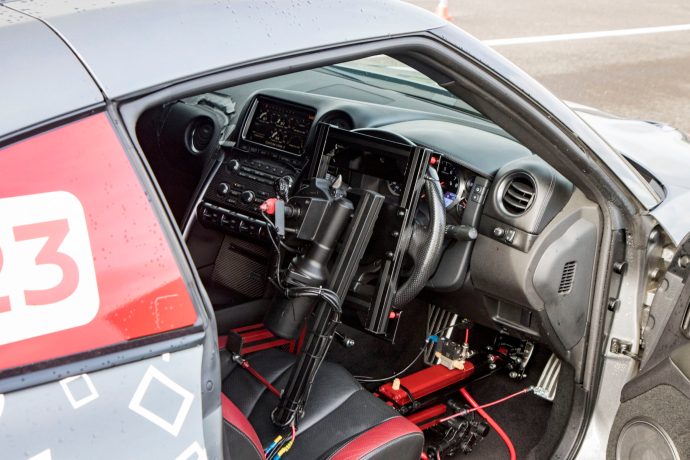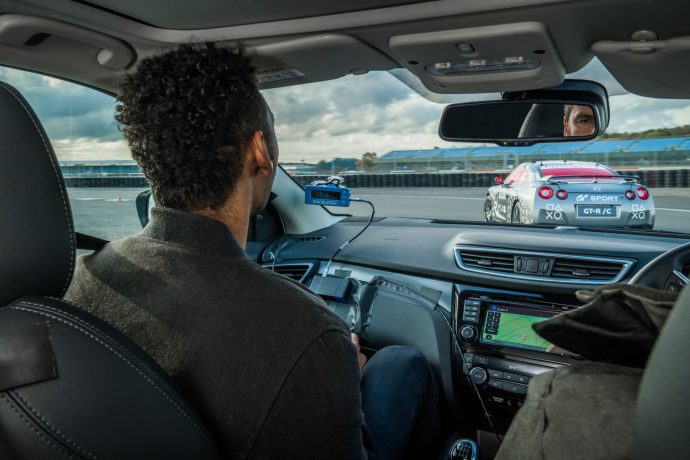Racing games like Assetto Corsa, Project Cars 2 and soon GT Sport have made gaming more realistic than ever, but without a steering wheel they feel largely disconnected from real-life driving. That is until now.
At an event earlier this week, Nissan invited me to drive a specially prepared GT-R not with a steering wheel, but remotely, with a PS4 controller – and it was surreal, nauseating and incredible in equal measure.
Why?
Unless if you’ve been living under a rock – or just don’t like racing games, you’ll know that GT Sport is out next week. Years of delays have made it one of the most highly anticipated racing games ever, and with a garage of 162 cars, jaw-dropping visuals and realistic handling, it should be one of the best, too.
To celebrate its release, I was invited to Nissan Adventures 2.0, an event which looked at the relationship between the GT-R and the Gran Turismo franchise – the reason why the Skyline is etched into my childhood memories.
In addition to driving all-new GT-Rs and a classic 1997 R34 model around Silverstone, Nissan also let me take control of the GT-R /C; a GT-R you could drive with a PS4 controller.
How does it work?
Before I explain how odd it is to recreate your gaming memories in real life, it’s worth explaining just how Nissan made this happen – because it’s an incredible feat of engineering.
On the outside, the GT-R /C looks like a “normal” car, but on the inside, there’s a wealth of highly complex contraptions that allow its novel control method. Four robots operate the steering, transmission, brakes and throttle, while six computers mounted in the boot update the controls at up to 100 times a second.
According to Dr James Brighton of JLB Design – one of the people that made this project a reality – it’s possible to divide the GT-R /C’s systems into three parts.
“The control system is taking those commands and interpreting them, and then giving us the vehicle control motions that we want in order to be able to effect what you want to do with the car,” Dr Brighton explains.
“So if you pull the throttle back and you want full throttle, it’ll give you full throttle. There’s a series of actuators in the front of the car which do that, and then we do all the control systems behind it, in order to give it the fidelity that we need to achieve the performance that we want.”
“Then we have a secondary system that’s a supervisory system that’s looking after the health of the car and the comms,” says Dr Brighton “And then effectively a sort of emergency kill-switch type system, which if either of the guys or me presses a button will stop the car.”
Built for speed
Making a real car respond to a PS4 controller is difficult enough, but Nissan wanted to go lap the car as fast as possible, and that meant carefully calibrating the controls for the best possible response.
“We looked at the game and we looked at how a GTR driven humanly goes round the circuit,” Dr Brighton tells me. “So we looked at the racing line, the vehicle dynamics and performance around the track, and we tried to achieve that.”
“[Steering is] gradual round the centre, and then it gets increasingly faster as you move further away from the centre,” says Dr Brighton. “So it’s a non linear ramp we’ve programmed for this particular application.”
Controlling the car
After hopping into the passenger seat of a Nissan Qashqai that would be driven behind the GTR /C I pushed the PlayStation logo to make the car’s systems “live”, and it was time to set off. In a normal GT-R that means easing into first gear, but this time, it meant gently squeezing the R2 trigger.
Driving a GT-R is a handful at the best of times, but driving it with a controller was a pretty precarious experience. The GT-R can top 196mph, and having that power under my finger – in real life – was a strange feeling. Despite playing Gran Turismo for the last 20 years, I found myself cautiously tiptoeing around the track – always worried about spearing off into a barrier.
The control themselves were great, and although the braking was relatively sudden, I could have got much faster over time. Instead, my main issue was judging the position of the car on the on track.
I took a while for my brain to control a real car I wasn’t in, and when I did get the hang of it, I’d realise I was using a PS4 controller and have to focus into things again. When combined with the movement of the chase car I was sitting in, that increased level of concentration made everything quite nauseating.
What’s more, the GT-R /C is a far more capable car than the Qashqai I was sitting in, and that meant sharp braking could have resulted in my chase car slamming into the remote car. There were one or two worrying occasions where my cautious, heavy braking caught out everyone – including myself – which wasn’t fun. At another corner, I braked and then steered far too sharply, slowly drifting into the path of our chase car. It wasn’t that bad, and it was an experience nonetheless.
In addition to driving the GT-R around a short course, I also had the opportunity to park it in a garage – and I found that activity even harder. I tried about four times, and was only successful on my last attempt. The other times I crashed into cones, as my depth perception worked over time, but ultimately failed.
How it’s done
Gran Turismo has always had a close relationship with Nissan, and that’s partly because of the GT Academy. A program designed to transform gamers into racers, it’s been going since 2008, and produced several impressive drivers. But the most famous has to be Jann Mardenborough.
Now an established driver racing driver, Jann got his break after winning a joint Nissan and Gran Turismo competition. And that’s why Nissan asked him to take the GT-R/C for a hot lap around the Silverstone National track.
Mardenborough first used a chase car while familiarising himself with the GT-R/C, but he ended up using a helicopter complete with a live feed of the car’s speed – to better judge corners. The result? A fastest lap of 1:17:47, with a top speed of 131 mph. To give some context, the remote-controlled lap had an average speed of 76 mph, while a human controlled lap had an average speed of 83 mph.
A 7mph difference over the course of a lap isn’t bad at all, and below you can see how him doing it below.
Disclaimer: Some pages on this site may include an affiliate link. This does not effect our editorial in any way.











